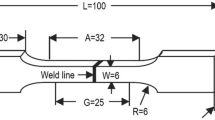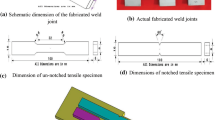Abstract
In this study, to clarify the effect of the loading mode on the fatigue properties of laser-welded joints, the fatigue properties and the fatigue crack behavior were experimentally investigated by using two types of laser-welded joint: tension-shear type (TS-type) and cross-tension type (CT-type). Furthermore, to clarify the effect of the bead width of laser welding on fatigue properties, CT-type joints with a wider bead width were also prepared (CT-wide-type). From static tensile and fatigue tests, TS-type and CT-type joints possess significant low fatigue resistance given the static strength of both joints. The macroscopic fracture morphologies of TS-type and CT-type joints with a narrow bead width are dependent on the applied force amplitude. However, the macroscopic fracture morphologies of CT-wide-type joints, which have a wider bead width, are not affected by the force amplitude level. In addition, using an external force to organize the fatigue strength of laser-welded joints with different loading modes is difficult. However, our fracture-mechanics approach based on the stress intensity factor at the slit tip, as calculated by FEM analyses, can be used to organize the fatigue strength of various joints irrespective of the loading mode.





















Similar content being viewed by others
References
Brauser S, Pepke LA, Weber G, Rethmeier M (2012) Influence of production-related gaps on strength properties and deformation behaviour of SPOT welded trip steel HCT690T. Welding in the World 56(3-6):115–125
Gaul H, Brauser S, Weber G, Rethmeier M (2011) Methods to obtain weld discontinuities in SPOT-welded joints made of advanced high-strength steels. Welding in the World 55(11-12):99–106
Smith S, Vrenken J, van der Veldt T (2013) Structural performance of adhesive and weld-bonded joints in AHSS. Welding in the World 57(1):147–156
Fischer C, Feltz O, Fricke W, Lazzarin P (2011) Application of the NOTCH stress intensity and crack propagation approaches to weld toe and root fatigue. Welding in the World 55(7-8):30–39
Pouranvari M, Marashi SPH (2013) Critical review of automotive steels spot welding: process, structure and properties. Sci Technol Weld Join 18(5):361–403
Gaul H, Weber G, Rethmeier M (2011) Influence of HAZ cracks on fatigue resistance of resistance spot welded joints made of advanced high strength steels. Sci Technol Weld Join 16(5):440–445
Khan MS, Bhole SD, Chen DL, Biro E, Boudreau G, van Deventer J (2009) Welding behaviour, microstructure and mechanical properties of dissimilar resistance spot welds between galvannealed HSLA350 and DP600 steels. Sci Technol Weld Join 14(7):616–625
Sam S, Shome M (2010) Static and fatigue performance of weld bonded dual phase steel sheets. Sci Technol Weld Join 15(3):242–247
Long X, Khanna SK (2008) Fatigue performance of spot welded and weld bonded advanced high strength steel sheets. Sci Technol Weld Join 13(3):241–247
Xu J, Zhang YS, Lai XM, Chen GL (2008) Experimental investigation of fatigue performance of spot welded dual phase sheet steels. Sci Technol Weld Join 13(8):726–731
Khanna SK, Long X (2008) Residual stresses in resistance spot welded steel joints. Sci Technol Weld Join 13(3):278–288
Tanegashima R, Akebono H, Kato M, Sugeta A (2011) 3-dimensional observation of fatigue crack propagation on SPOT welded joints using high strength steel. Int J Autom Eng 2(3):61–67
Tanegashima R, Ohara I, Akebono H, Kato M, Sugeta A (2015) Cumulative fatigue damage evaluations on spot-welded joints using 590MPa-class automobile steel. Fatigue & Fract Eng Mater & Struct 38(7):870–879
Tanegashima R, Akebono H, Kato M, Sugeta A (2013) 3-Dimensional observation of the interior fracture mechanism and establishment of cumulative fatigue damage evaluation on spot welded joints using 590 MPa-class steel. Int J Fatigue 51:121–131
Neubert J, Kranz B (2013) Characteristics and strength behaviour of laser hybrid welds on T- and butt joints considering European and international standards. Welding in the World 57(3):373–382
Daneshpour S, Kocak M, Riekehr S, Gerritsen CHJ (2009) Mechanical characterization and fatigue performance of laser and resistance SPOT welds. Welding in the World 53(9-10):221–228
Daneshpour S, Kocak M, Bayraktar FS, Riekehr S (2009) Damage tolerance analyses of laser welded “skin-clip” joints for aerospace applications. Welding in the World 53(3-4):90–98
Sakino Y, Sano Y, Sumiya R, Kim YC (2012) Major factor causing improvement in fatigue strength of butt welded steel joints after laser peening without coating. Sci Technol Weld Join 17(5):402–407
Daneshpour S, Riekehr S, Kocak M, Gerritsen CHJ (2009) Mechanical and fatigue behaviour of laser and resistance spot welds in advanced high strength steels. Sci Technol Weld Join 14(1):20–25
Bergmann JP (2005) Mechanical behaviour of overlap joints of titanium. Sci Technol Weld Join 10(1):50–60
Dasgupta AK, Mazumder J (2008) Laser welding of zinc coated steel: an alternative to resistance spot welding. Sci Technol Weld Join 13(3):289–293
Acknowledgments
This work has been supported by the Grant-in-Aid for Scientific Research (B) no.25289009 of JSPS KAKENHI Grant from 2013. We are grateful for their support. Also, the authors would like to thank a section of fatigue reliability in Society of Automotive Engineers of Japan for supplying the materials.
Author information
Authors and Affiliations
Corresponding author
Additional information
Recommended for publication by Commission XIII - Fatigue of Welded Components and Structures
Rights and permissions
About this article
Cite this article
Inohara, M., Akebono, H., Kato, M. et al. Effects of loading mode on the fatigue behavior of laser welds in automobile mild steel sheet. Weld World 60, 535–545 (2016). https://doi.org/10.1007/s40194-016-0303-2
Received:
Accepted:
Published:
Issue Date:
DOI: https://doi.org/10.1007/s40194-016-0303-2




